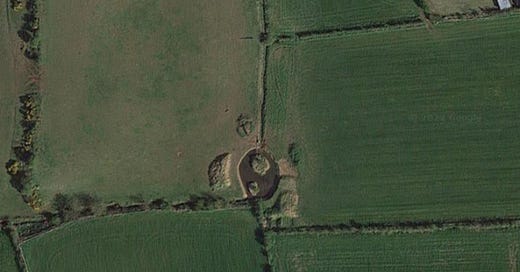
Just outside the village of Bushmills in County Antrim is a townland named ‘Eagry’. The name is best known locally from the modern housing estate named ‘The Eagry’. The name is also given to an old farmhouse and bridge a small way up the Haw Road toward the hamlet (and namesake of the parish) Billy. The parish is filled with the remains of medieval forts, souterrains, cairns, raths, and churches – many of which met their demise in raids and violent attacks. One of these forts, however, was supposedly the site of a dinner-table massacre, straight from a Shakespearean tragedy – the fort of Wine Hill.
‘The Massacre of Wine Hill’, as the Ordinance Survey Memoirs deem it, perhaps took place in the mid-sixteenth century. The alliance between the McQuillans and MacDonnells in the McQuillan-O’Cahan feud was broken from anywhere between 1559 to 1569 according to the Rev. George Hill.1 The McDonnells – the famous Sorley Boy MacDonnell as their leader – turned on the McQuillans and laid siege to the Route, defeating them, gaining control over the area, and taking Dunluce Castle. The latest O.S. memoirist of Billy Parish, J. Stokes, writing in 1838, noted the Massacre of Wine Hill as ‘one of these battles’ in the McQuillan-MacDonnell conflict, and calls it a ‘treachery’.2 The earlier memoirist, Thomas Hore gives the full account of the massacre:
[The two] clans, the McQuillans and the McDonnells [sic], had been for some time fighting about a tract of land. At length the latter, wishing to put an end to the contest rather by intrigue than by fair fighting, made overtures of peace and invited the former to a great feast to be held on the top of this hill. Much wine was provided and the guests artfully arranged so that every McDonnell should have a McQuillan at his left hand. Each of the former also had a dagger concealed in his garments. After dinner, at a given signal, the innocent and unsuspecting guests were at once murdered. The blood which flowed from the short struggle mingled itself with the wine of the feast and, flowing over the brow of the hill, gave it the name of the Wine hill, which it has retained ever since. [. . .] In cultivating its borders there have been found from time to time many human bones believed to have been those of the murdered McQuillans. By this act of treachery the other party succeeded in getting possession of the disputed territory. Near the hill there formerly stood a triangular entrenchment believed to have been for some military purpose of these clans. It has been destroyed by the occupying tenant.3
So was this event a part of the sixteenth-century conflict? Possibly. However, the families fought principally through battles at ‘Bonamargy, Glenshesk and [a] final battle at Aura’ according to one source,4 while the Rev. George Hill points out that there is contradictory evidence in ‘family manuscripts’ and local history of where the first battle occurred, which battlefields were fought on, and when the conflict even took place.5 Whether this dinner feast ambush fits into the historical narrative is not immediately clear to the author. It is perhaps possible that the massacre took place years before the conflict, between local branches of the family, and the ‘tract of land’ was much smaller, not denoting the Route itself. The massacre and destruction of the fort perhaps came from the Wine Hill story as told by Hore, then got later associated with the mid-sixteenth-century conflict; or, the fort was destroyed at this date and got associated with the earlier massacre event in the local conscience; and so on with different combinations. It also must be put forth that J. Stokes may have been connecting these two events errantly, or one of his oral sources, which he cites as ‘Informants John Stewart, Samuel McCurdy and others’.6
Whatever the case, ‘from time to time, there were quantities of every description of human bones found beneath the surface and believed to be those of the murdered McQuillans.’7 There were even two brass war horns found close to the hill, which were purportedly sold to a London museum.8
June Traill of Ballylough House - built next to the ruins of Ballylough Castle, once owned by the McQuillans - notes that a field nearby is called Whinny Hill,9 perhaps indicating the historicity of the event, or at least its weight in the family history of the McQuillans and the naming of local places.

I will also tentatively suggest that this could just be a folktale set in a real historical period – a period quite traumatic for the people of the Route. Perhaps it reflects what was a historic battle and destruction of a fort on Wine Hill, which with time mutated and took on the folkloric elements of the blood flowing down the hill like wine, the dinner table setting with its xenia-violation, and the seating arrangement of every MacDonnell having a McQuillan at his left hand. Often, however, fact can be stranger than fiction. I will conjecture no more.
You can view the site of Wine Hill for yourself here on Google Maps:
And here on the PRONI Historic Environment Map Viewer:
https://apps.spatialni.gov.uk/PRONIApplication/?marker=294797.08957751247%2C440012.36929557193%2C29900&markertemplate=%7B%22title%22%3A%22EAGRY%20(Billy)%22%2C%22x%22%3A294797.08957751247%2C%22y%22%3A440012.36929557193%2C%22wkid%22%3A29900%2C%22isIncludeShareUrl%22%3Atrue%7D&level=14
Rev. George Hill, An Historical Account of the MacDonnells of Antrim: Including Notices of some other Septs, Irish and Scottish (Belfast, 1873), p. 124.
Angélique Day and Patrick McWilliams eds., Ordinance Survey Memoirs of Ireland 16: Parishes of County Antrim V 1830-5, 1837-8: Giant’s Causeway and Ballymoney (Belfast, 1992), p 71.
Ibid., p. 53.
‘Feud with Clan McQuillan’, Clan Kane website. https://web.archive.org/web/20090505130812/http://clankane.net/Fued_With_the_mcquillans.htm [accessed 22 July, 2024]
Hill, MacDonnells of Antrim…, p. 124.
Day and McWilliams eds., Ordinance Survey Memoirs of Ireland 16, p 71.
Ibid., p. 67.
Ibid., p. 67.
June Traill and Catherine Charley, Our Ballylough Research Journey (Ballymoney, 2020), p. 82.



